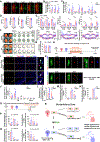Increasing Mononuclear Diploid Cardiomyocytes by Loss of E2F Transcription Factor 7/8 Fails to Improve Cardiac Regeneration After Infarct
- PMID: 36622904
- PMCID: PMC9988404
- DOI: 10.1161/CIRCULATIONAHA.122.061018
Increasing Mononuclear Diploid Cardiomyocytes by Loss of E2F Transcription Factor 7/8 Fails to Improve Cardiac Regeneration After Infarct
Keywords: E2f7; E2f8; heart regeneration; mononuclear diploid cardiomyocytes; polyploidization; proliferation.
Figures

Comment in
-
A Tedious Journey: Cardiomyocyte Proliferation Requires More Than S-Phase Entry and Loss of Polyploidization.Circulation. 2023 Jan 10;147(2):154-157. doi: 10.1161/CIRCULATIONAHA.122.062784. Epub 2023 Jan 9. Circulation. 2023. PMID: 36622907 No abstract available.
References
-
- Windmueller R, Leach JP, Babu A, Zhou S, Morley MP, Wakabayashi A, Petrenko NB, Viatour P, Morrisey EE. Direct comparison of mononucleated and binucleated cardiomyocytes reveals molecular mechanisms underlying distinct proliferative competencies. Cell Rep. 2020;30:3105–3116.e4. doi: 10.1016/j.celrep.2020.02.034 - DOI - PMC - PubMed
-
- Hesse M, Bednarz R, Carls E, Becker C, Bondareva O, Lother A, Geisen C, Dressen M, Krane M, Roell W, et al. Proximity to injury, but neither number of nuclei nor ploidy define pathological adaptation and plasticity in cardiomyocytes. J Mol Cell Cardiol. 2021;152:95–104. doi: 10.1016/j.yjmcc.2020.11.012 - DOI - PubMed
Publication types
MeSH terms
Substances
Grants and funding
LinkOut - more resources
Full Text Sources

